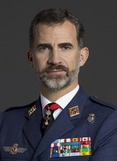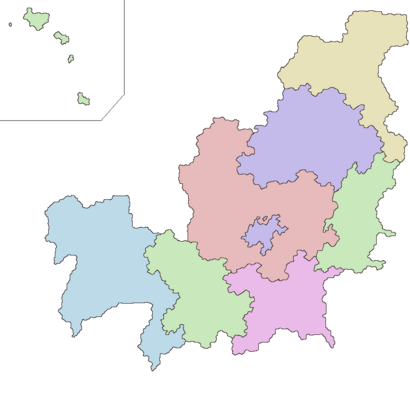Mirina
Crown of Mirina Kurun di Mbrin Mirinko Koroa | |
|---|---|
| Motto: Mi Mar, Vos Rega My sea, your king | |
| Capital and | Iulan |
| Official languages | Mirine |
| Government | |
• Queen | Imeli II |
| Filip, Duke of Kulumbra | |
| Ntoni Mitisalikari | |
| Legislature | Stat Gindral |
| Grand Council | |
| General Council | |
| Population | |
• 2019 census | 23,451,265 |
Mirina (Mirine: Mbrin), officially the Crown of Mirina (Mirine: Kurun di Mbrin)
Etymology
History
Prehistory
Antiquity
Middle Ages
Early Modern
Siul Republic and SKP Mirina
The First Mirine Republic was declared in Siul on the 11th March 1922 by Mbrakel Vekrivisari, who served as its first president. The First Republic faced many problems, including several counter-revolutions sponsored by Tigulia and Atresca, relying upon Vvardenese support to maintain military and social control. A weak presidency and failure of coalition governments saw 13 ministries between 1922 and 1924, along with a failure to combat rising inflation and unemployment. In May 1924 Vekrivisari dissolved parliament and promulgated a new constitution, forming the Second Republic with an enhanced presidency.
The Second Republic saw decreased tensions between Mirina and Tigulia and an economic stabilisation, but despite this it faced significant social turmoil and economic disturbances. The problem of coalition governments and weak ministries was not solved, and by 1926 the majority of legislation came from presidential decrees. In October 1927 the National Convention passed legislation restricting the powers of the presidency, Vekrivisari responded by vetoing the legislation, dissolving the Convention, and passing an emergency decree placing all executive and legislative authority in his office until the promulgation of a new constitution.
By January 1928 Vekrivisari's second term was nearing its end, with the Convention having been dissolved for almost four months and no constitution in sight. The Convention unofficially reconvened in the August Palace, though it was boycotted by the Social-Democrats and the SKP, and the majority of its members were arrested. Protests began in February when Vekrivisari passed a decree extending his term, and after the shooting of Flur Balatur turned into a full rebellion.
The SKP was able to direct the revolt and establish a socialist republic following the tenets of Grevaism. The SKP attempted to radically reorganise Mirine society, having judged the prior republics to have failed due to lingering monarchical sentiment and traditionalist thought. This would culminate in the small but significant Kretain massacre and contributed to an increased Mirine emigration to the new world. The SKP were internationalist in thought, seeking to expand the revolution to neighbouring Tigulia and Vvarden. Increased tensions with the former led to Tigulia declaring war on February 1929.
Lavender Revolution and Li Ristultiun
-people in Mirina refuse to fight
-come out in droves wearing Lavenders to protest conscription laws
-SKP government collapses. Plebiscite held and monarchy restored
-Next twenty years see struggle between monarch and parliament over powers, budget, etc.
Contemporary period
Geography
Politics
Mirina is a unitary state under a constitutional monarchy. Queen Imila II is the monarch and head of state of Mirina. The constitution grants the monarch executive and honorific powers. They preside over the Privy Council; appoints the Prime Minister, usually from the political party that has won the most seats in the parliamentary elections, and on recommendations from the latter, appoints the members of the government. The monarch also has the power to terminate the tenure of any minister, and to unilaterally dissolve the Parliament, suspend the constitution, call for new elections, or rule by decree. The monarch is formally the commander-in-chief of the armed forces.
Government
Mirina has a parliamentary government based on the x model. The Stat Gindral of Mirina meets in the August Palace and has two houses: an elected General Council and a appointed Grand Council. All bills passed must be given Royal Assent before becoming law.
The position of prime minister (Mirine: Dombra Pristent Kunkeli, Lord President of the Council), Mirina's head of government, belongs to the person most likely to command the confidence of the General Council; this individual is typically the leader of the political party or coalition of parties that holds the largest number of seats in that chamber. The prime minister chooses a cabinet and its members are formally appointed by the monarch to form Her Majesty's Government. By convention, the monarch respects the prime minister's decisions of government.
The cabinet is traditionally drawn from members of the prime minister's party or coalition and mostly from the Commons Chamber but always from both legislative houses, the cabinet being responsible to both. Executive power is exercised by the prime minister and cabinet, all of whom are sworn into the Privy Council of Mirina, and become Ministers of the Crown. The current Prime Minister is Ntoni Mitisalikari, leader of the Alydian People's Party, who has been in office since 12 June 2014. Mirina is divided into 300 constituencies, used to elect members of the General Council. General elections are called by the monarch when the prime minister so advises, and by convention should be called within five years of the last.
Devolved administrations
Mirina, Pontra, Tembra, Sodna, and Apia each have their own government and executive, led by a president and a devolved bicameral legislature.
| Mirina | Iulan | Mirina-Li Makra | Mabreta | Visteli | Pontra | Tembra | Paluda | Apian Isles | |
|---|---|---|---|---|---|---|---|---|---|
| Flag | |||||||||
| Capital | Siul | Iulan | Badaisa | Skipiun | Kuloni | Ramani | Midrani | Kratagna | Brak |
| Parliament | Krut Gindral of Mirina | Iunt of Iulan | Krut of Mirina-La Makra | Krut of Mabreta | Vestiline Krut | Supril Krut of Pontra | Tembran Gindraltat | Iunt of Paluda | Apian Krut |
| Current president | Sivil Istatari | Grinaldi Sulutot | Stifan Nukuntan | Mikel Iakatinlak | Krodi Suprapasat | Galteri Kavalus | Vitori Naskrutatur | Svitoni Mumbrukan | Ioli Pridat |
| Population (2018) | TBD | TBD | TBD | TBD | TBD | TBD | TBD | TBD | TBD |
| Area | TBD/km2 | TBD/km2 | TBD/km2 | TBD/km2 | TBD/km2 | TBD/km2 | TBD/km2 | TBD/km2 | TBD/km2 |
| Density | TBD/km2 | TBD/km2 | TBD/km2 | TBD/km2 | TBD/km2 | TBD/km2 | TBD/km2 | TBD/km2 | TBD/km2 |







